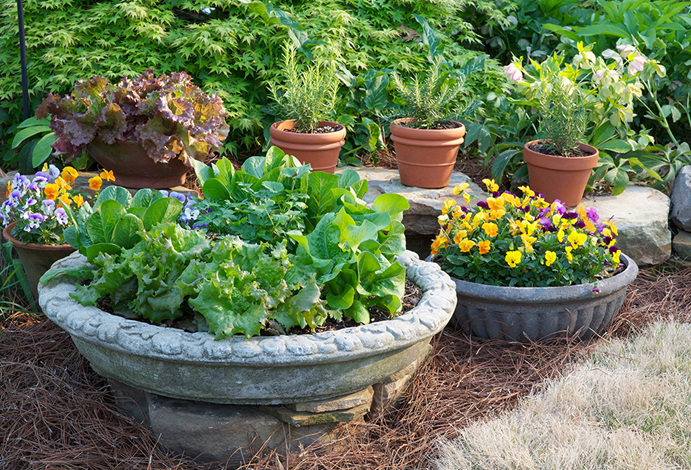Container gardens allow you to easily dress up your balcony and patio, create a colorful welcome for guests and keep edibles close at hand for cooking and entertaining. They’re also a terrific way for new gardeners to get their start. Increase your success growing vegetables, herbs or flowers in a container with these tips.
Proper plant selection. Select the right plants for the container and growing conditions. Closely check the plant tags for this and more information to help with your decision. Create attractive combinations with plants that look good together and require the same growing conditions.
And don’t be afraid to mix flowers, herbs and vegetables. This is a great way to have both beauty and flavor on your patio, deck or balcony. Scour gardening magazines and the internet for free container planting plans like those featured www.bonnieplants.com.
Selecting the right container. Further increase your success by selecting a container large enough to accommodate your plants. The bigger the pot, the more moisture it can hold, maximizing the time between watering. A small pot with a large plant will need to be watered several times a day during hot weather and fertilized more frequently.
Use a container with drainage holes made from material suited to your gardening style and climate. Even if you could provide the exact amount of water your plants need, nature may intervene with an extra dose or two. Drainage holes prevent water from building up in the bottom of the pot, leading to root rot.
Those in areas with hot summers should avoid black and metal pots that can heat up in the summer sun and damage tender plant roots. Terra cotta pots are a traditional favorite. They are attractive, heavy and dry out more quickly than some other materials. Glazed pots are beautiful, but tend to be pricey and heavy to move. Plastic pots are affordable, come in a variety of styles and don’t dry out as quickly as terracotta. Then there’s the sturdy half whiskey barrel. This planter is a longtime favorite, but be sure to drill drainage holes in the bottom if it doesn’t already have them.
Potting mix. Next, invest in a quality potting mix that holds moisture, yet provides adequate drainage. These are usually a combination of peat moss, compost or coir to hold moisture, and perlite or vermiculite to aid in drainage. Leave garden soil in the garden where it belongs, not in containers.
Watering. Check the potting soil moisture in your container gardens at least once a day and more often if the pots are small or temperatures high. Water thoroughly when the top inch of soil is dry and allow the excess to run out the drainage holes. This shows you have moistened the potting mix, top to bottom, encouraging a robust root system to develop.
Extend the time between waterings with the help of self-watering pots. Their built-in water reservoirs provide water to the plants as the soil dries. Fill the reservoir as needed and make sure there is a weep hole. This allows excess water to drain out of the reservoir instead of saturating the soil and leading to root rot.
Fertilization. Lastly, incorporate a slow release fertilizer into the potting mix at planting. This type of fertilizer provides small amounts of nutrients over a longer time period. Follow label directions and make additional applications as recommended on the fertilizer label.
As your container plants continue to thrive and you enjoy the flavorful vegetables and herbs and gorgeous flowers they provide, you’ll soon be looking for more spaces to incorporate container gardens into your landscape.
Melinda Myers has written more than 20 gardening books, including Small Space Gardening. She hosts The Great Courses “How to Grow Anything” gardening DVD series and the nationally syndicated Melinda’s Garden Moment TV & radio segments. For more information, please visit www.melindamyers.com.

